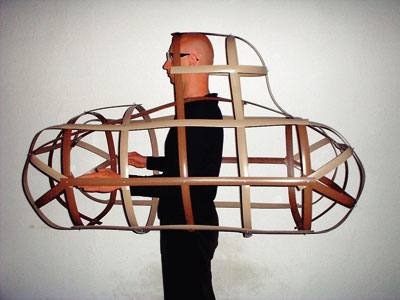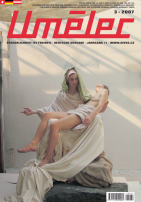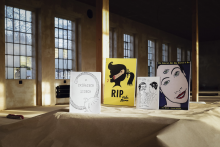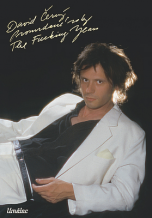| Umělec magazine 2007/3 >> SUPERJAMBON’s Know - How | List of all editions. | ||||||||||||
|
|||||||||||||
SUPERJAMBON’s Know - HowUmělec magazine 2007/301.03.2007 Marta Jecu | walking | en cs de es |
|||||||||||||
|
Even before entering the location where Patrick Jambon performs, you can see him from far away, from the street; he’s in the window of the gallery racing cars on a computer attached to a home trainer that he pedals throughout the opening of his show.
Visible and exposed, approachable and inviting, Patrick Jambon utters statements at epicenters of public reception —be they in an art setting or otherwise, they are statements that are neither provocative, polemic nor demonstrative and militant. Patrick Jambon plays with digital cyborgs and mechanical robots, with recyclable and non-recyclable objects, with computers and steering wheels. He constructs Utopias and deconstructs them back again. All the values he plays with are pushed into continuous transformation. He alters perspectives, rolls from one perception to another over objects, images and ideas and explores the natural absurdity of daily situations, concepts and ideologies. All the while that he uninhibitedly plays his games, Patrick Jambon, in his serene manner, is also toying with the norms of the performance tradition. His allusions to patterns found in Sixties and Seventies conceptual and performance art are both subversive and demystifying. The ingrained cycle of assimilation and interpretation of canonical patterns, that rely on “tradition” or “the Masters,” is inverted in his interventions. Jambon’s actions play around not only with the authority of “tradition,” but also with the authority of the artist-author and the authority of the public. Strongly bound to authorship, institutionalized forms of performance art are redirected by Jambon like stock information to be redistributed with an eye to contamination, but in a productive, everyday manner; while the artist-to-public power relationship is annulled. His interventions assert no finality and do not anticipate any productive reception from the public. In this way, he ironically denies the claim for objective validation of his art action, and also denies the selfhood and individuality of the artist-author. As Patrick Jambon’s discourse is not one that judges, the public is not given the opportunity to depart from his actions with any satisfaction of having “constated” or “concluded” anything: the audience is invited to play whatever game he proposes, and to enjoy it—or not. His games deny fixed identity roles, yet propose to “act oneself out.” Singing karaoke, riding on a hometrainer, swimming in a plastic tub in the middle of the street, or racing around town playing carraces on a portable computer—the opportunity is presented to reenact some socially established contexts and the clichés of their interpretation. The audience does what is done habitually: we follow our expected everyday patterns of reaction, but find ourselves plunged into a deeper level of signification. Tricky and witty, Patrick Jambon turns computers into cars, ribbons and bicycle lights into costumes, texts into images, adults into babies, people into robots. Our “misunderstanding” seems to me the generative force of Patrick Jambon’s performances. Playing our roles and enacting Patrick’s role, suddenly a comic conceptual distance comes about that undermines the habitual patterns of interpretation. GENDER GAMES Likewise, gender is no essentialist model of representation. Patrick and Patricia trade roles on a sunny afternoon in a field of sheep. In these images, gender is a moment in the present that proposes optional possible presences. Here again, after a moment of “misunderstanding,” the viewer is tricked into seeing a difference (Patrick or Patricia?) made by repetition and resignation. Patrick Jambon engages in twin chronological directions in his works. Born in 1966 in Lyon, France, the artist studied video (1988 -1993) at the Düsseldorf art academy—not by chance—in the class of Nam June Paik. Jambon continued at the Academy of Media Arts in Cologne and, from 2002 to 2005, followed the “Art in Context” in Berlin. Even though his expression is compact and unified, his actions from the Nineties construct, quoting ironically, fleeting situations sculptured with minimal, coincidental interaction. His later works work with the audience in an evolving process. He sees his interventions less as performances than “interactive installations.” Posed in an environmental or social context, the body makes a statement of its own; and walking serves as a sculptural device. In some of Patrick Jambon’s early photography and actions, we can observe his body as a mobile object located in public space. The body, extended, amplified or minimized by different self-attached shapes or objects, is enhanced, and its functions are rendered autonomous. The body becomes a latent expression of a multiplicity of possibilities. It has no fixed form, but can be fixed and transformed through the image. By placing himself in dialog with different contexts, his interventions construct not only an architecture of the abstracted body, but declare social implications of the body. Self-referential, this attitude can be summed up in the character of Superjambon—the prototype of this ironically extended being. Mundane objects attached to the body are transformed into extravagant robotic accessories and manufactured human organs that suggest a more fictitious than scientific purpose. It is rather a “monde a l’envers,” where clichés from TV-movies and advertisement are brought into the real world of the street. Dustbins attached on the forehead, bicycle lights fixed on the entire body and blinking continuously, plastic frames used as extraterrestrial head-gear of a lunatic in front of a Buddhist temple. Computer collages or mis-en-scene live-sculptures, these images function as sketches for future actions. These sculptural interventions are interchanged as the body is kept in constant transformation. Structures made of plastic and linoleum mouldings, of floppy disks, of woven videotape envelope the body and reconfigure its functions. As he explains they are “partly biological, partly mechanical. The skeletons that I constructed from floppy disks represent an extension of memory, of human storage capacity.” Also made out of floppies is the mobile office for bank employees that can be used for standing or sitting inside. It was worn by him for the opening and then exhibited, in the location of a former bankrupt bank in Berlin. “I was thinking about the ex-employees of this bankrupt bank. What happened to them? Are they unemployed, homeless? How can they survive now? So I offer a mobile working place from parts of an office, so they could continue working. This working place is mobile, flexible and they could also live in there.” ROBOT GAMES This passion for mechanical robots, digital hominids, clones, cyborgs, and prosthetic bodies resonates with contemporary art and theory of the Eighties, with a new interpretative model substituting one-dimensional experiences with the multidimensionality of digital codes. The “post-evolutionary” time, in which chronologies no longer justify or legitimize the development of phenomena, combines elements from different codes in the same conceptual frame: anatomic parts and artificial limbs can function together in a more intensive, productive and democratic framework. An artist like Stelarc, with whose work Patrick Jambon’s interactive installations bear similitude, declares the necessity of the prosthetic body. For him, “the body is obsolete” - unable to adapt to the present technological environment as a pure biological species. In his performances, he constructs artificial extensions on his body (for example a third arm, virtual arms and ears) controlled by digital information. Patrick Jambon’s discourse is with artificial extensions, situations of substitutions between virtual and physical, experiences of mechanization or digitalization construct also an aesthetic of the body. Nevertheless, Patrick Jambon’s discourse turns into another direction than does the demonstrative and phobic doctrine of Stelarc. Patrick Jambon rather challenges the clichés of these already established theoretical patterns and follows their effects, in an ironic game, down to their social and behavioral implications. He reproduces familiar images, but deconstructs them using their own means. Like in all his works, he maintains a distance to what he presents anew, thus deconstructing at the same time. WALKING Recent works deal with transformation on a more social level. His urban trajectories— walking with machines or computers attached to his body—engage with passers by, usually by offerings of food, entertainment or clothing. For Michel de Certeau, walking “is a spatial acting out of the place” and therefore “walking is a space of enunciation.” This rhetoric of walking has, for de Certeau, the power to manipulate the basic elements of a constructed social order. Walking is a practice that by its ambiguity tricks institutional and political power. Surveillance is diverted by drifting away. Playful and threatening, the walker moves among the interstices of the public codes, making by resistance a political statement. For Patrick Jambon, walking in the streets brings about a democratization of experience and a way to exercise what he calls “Ich Ag.” Inspired by Berlin sausage street vendors who carry their equipment attached to their bodies, Patrick Jambon designed portable basket-costumes for actions in Berlin and Chile. Sauntering freely through the streets, he beckons people to participate with his model of social communication. These actions function as a public nucleus and the artist as the model of the creative , non - alienated , self - reliant activist. But Patrick Jambon is neither activist nor a militant for pre-determined political ideas. His playful approach on ideas and ideologies is rather meant to push the potential of social situations and reactions towards unexpected and innovative directions. At his intervention organised by Museo de Arte Contemporaneo in Santiago de Chile he proposed a model trade interaction: the German sausages he had in his baskets were exchanged for anything the passersby would offer. Jambon describes it this way: “The predetermined context within which my work is positioned is the predominant model of the neo-liberal global economy that has suspended the state commitment towards the people, demanding self-sustainable individuals. I propose to inventory elements of the theory of the free market and the strategies of its operations, in order to try new forms of self-sustainability and democratization, through artistic processes developed in the street, but doing it by exaggerating, by using the irony. I consider the street as a nondiscriminatory, open and participative space. My concern is to display a mobile place of exhibition, that overpasses the borders between body, architecture, art and commerce, the man and the economic offer.” At other interventions in Munich and Berlin, Patrick Jambon and Sunny Im attached to their bodies plastic baskets filled with second-hand clothing intended for an aid campaign. Mingling among street vendors, they offered the clothing, packed and redesigned in labeled envelopes, to people. Intended for the unemployed and homeless, the clothing all carried the label LOS (in german: -less). Always in motion, with all the necessary utensils packed portably and adapted to anatomic functions, Patrick Jambon’s actions offer instant soups or small breads, dancing and singing karaoke, aerobics or the opportunity to participate in car racing by pushing bicycles. Patrick Jambon steps serenely out of the artist’s role, for Superjambon can perform any role.
01.03.2007
Recommended articles
|
|||||||||||||
|
04.02.2020 10:17
Letošní 50. ročník Art Basel přilákal celkem 93 000 návštěvníků a sběratelů z 80 zemí světa. 290 prémiových galerií představilo umělecká díla od počátku 20. století až po současnost. Hlavní sektor přehlídky, tradičně v prvním patře výstavního prostoru, představil 232 předních galerií z celého světa nabízející umění nejvyšší kvality. Veletrh ukázal vzestupný trend prodeje prostřednictvím galerií jak soukromým sbírkám, tak i institucím. Kromě hlavního veletrhu stály za návštěvu i ty přidružené: Volta, Liste a Photo Basel, k tomu doprovodné programy a výstavy v místních institucích, které kvalitou daleko přesahují hranice města tj. Kunsthalle Basel, Kunstmuseum, Tinguely muzeum nebo Fondation Beyeler.
|




































 New book by I.M.Jirous in English at our online bookshop.
New book by I.M.Jirous in English at our online bookshop.
Comments
There are currently no comments.Add new comment